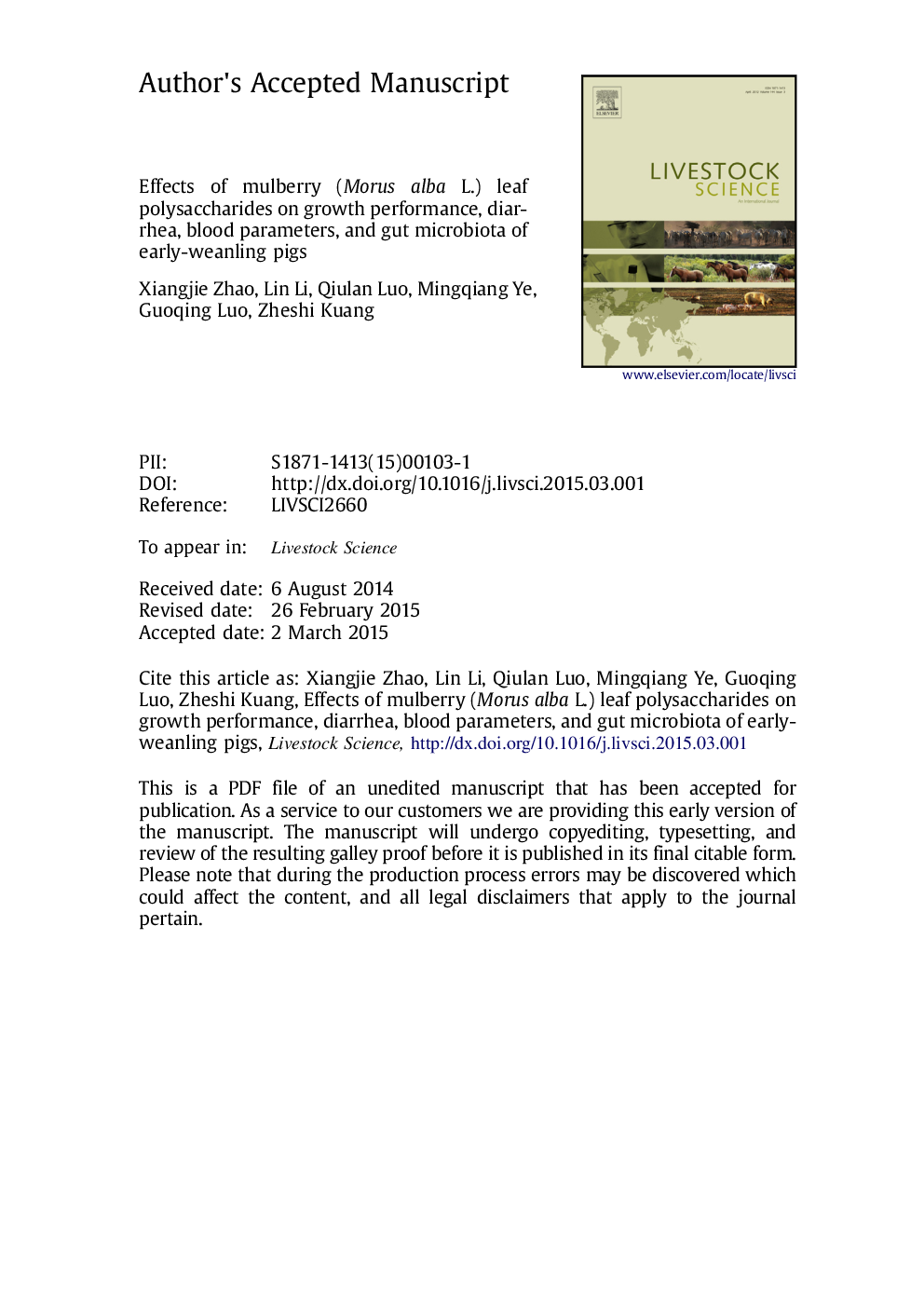| کد مقاله | کد نشریه | سال انتشار | مقاله انگلیسی | نسخه تمام متن |
|---|---|---|---|---|
| 5790004 | 1553955 | 2015 | 26 صفحه PDF | دانلود رایگان |
عنوان انگلیسی مقاله ISI
Effects of mulberry (Morus alba L.) leaf polysaccharides on growth performance, diarrhea, blood parameters, and gut microbiota of early-weanling pigs
ترجمه فارسی عنوان
اثرات پلی ساکارید برگ بر روی عملکرد رشد، اسهال، پارامترهای خون، و میکروبیوتا روده در خوک های زودگذر
دانلود مقاله + سفارش ترجمه
دانلود مقاله ISI انگلیسی
رایگان برای ایرانیان
موضوعات مرتبط
علوم زیستی و بیوفناوری
علوم کشاورزی و بیولوژیک
علوم دامی و جانورشناسی
چکیده انگلیسی
This study aimed to investigate the effects of mulberry leaf polysaccharides (MLPs) dietary supplements on the growth performance, diarrhea, blood biochemical parameters, and gut microbiota of early weanling piglets. A total of 150 Duroc-Landrace-Yorkshire crossbred weanling pigs (age: 28±2 d; body weight: 9.18±0.46 kg), were used in this study. Subjects were randomly divided into five treatment groups with six replicates in each group (n=5 animals per replicate). The dietary treatments were as follows: (1) control treatment (CT): basal diet (BD); (2) low-dose MLPs treatment (LT): 0.3 g/kg of MLPs+BD; (3) medium-dose MLPs treatment (MT): 0.6 g/kg of MLPs+BD; (4) high-dose MLPs treatment (HT): 0.9 g/kg of MLPs+BD; and (5) antibiotic treatment (AT): 0.15 g/kg chlortetracycline+BD. The fasting weight of each animal was measured and recorded in the morning at three time points (0, 10, and 21 d) in addition to food intake per pigpen. These data were then used to calculate the average daily gain (ADG), average daily feed intake (ADFI), and feed-to-gain (F/G) ratio of each subject. The diarrheal status of each piglet was examined and recorded twice daily (morning and afternoon). At the end of the experiment, blood samples were collected for biochemical analysis, and the contents from the ceacum, colon, and rectum were harvested to identify and quantify relevant gut microbiota. Our results showed that there was no significant differences in the ADG, ADFI, or F/G ratio among MLPs-treated groups (P>0.05), but the ADFI in LT, MT, and HT groups were all higher than those of both the CT and AT groups. Additionally, the F/G ratios in LT, MT, and HT groups were lower than those in the CT and AT groups. The LT, MT and HT groups showed a significant reduction in diarrheal incidence (P<0.05) when compared to the CT and AT groups. Biochemical analysis revealed that blood glucose (GLU) levels in all MLPs-treated groups were significantly (P<0.05) lower than in either the CT or AT groups. Blood urea nitrogen (BUN) levels in the MT and HT groups were significantly (P<0.05) different from those in CT and AT group and T3 levels in HT were significantly (P<0.05) higher than those in either the CT or AT groups. Although T4 levels in MLPs-treated groups were not significantly different from the AT control group, both IGF-1 and GH levels in the MT group were significantly higher than those in either the CT or AT groups (P<0.05). Our microbiota results indicated that the overall effects of LT, MT, and HT in both inhibiting gut Escherichia coli and in promoting gut lactobacilli and bifidobacteria were superior than those of both the CT and AT groups. Notably, the HT group (0.9 g/kg MLPs) showed a significantly better inhibitory effect on gut E. coli as well as a significantly better promotional effect on gut-beneficial bacteria when compared to both the CT and AT groups (P<0.05). Collectively, these results suggest that dietary addition of MLPs can improve the ecology of gut microbiota, reduce diarrhea rate, and improve the overall growth performance in early-weanling pigs.
ناشر
Database: Elsevier - ScienceDirect (ساینس دایرکت)
Journal: Livestock Science - Volume 177, July 2015, Pages 88-94
Journal: Livestock Science - Volume 177, July 2015, Pages 88-94
نویسندگان
Xiangjie Zhao, Lin Li, Qiulan Luo, Mingqiang Ye, Guoqing Luo, Zheshi Kuang,
